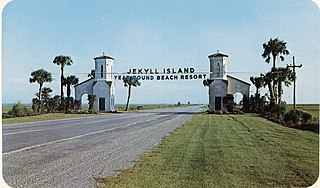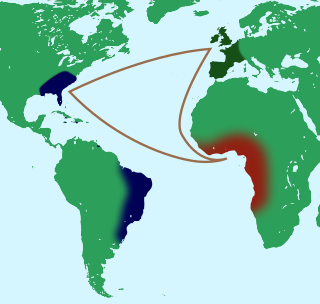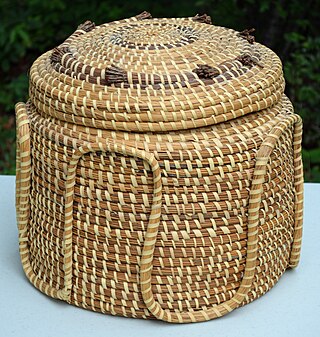A mojo, in the African-American spiritual practice called Hoodoo, is an amulet consisting of a flannel bag containing one or more magical items. It is a "prayer in a bag", or a spell that can be carried with or on the host's body. Alternative American names for the mojo bag include gris-gris bag, hand, mojo hand, toby, nation sack,conjure hand, lucky hand, conjure bag, juju bag, trick bag, tricken bag, root bag, and jomo. The word mojo also refers to magic and charms. Mojo containers are bags, gourds, bottles, shells, and other containers. The making of mojo bags in Hoodoo is a system of African-American occult magic. The creation of mojo bags is an esoteric system that involves sometimes housing spirits inside of bags for either protection, healing, or harm and to consult with spirits. Other times mojo bags are created to manifest results in a person's life such as good-luck, money or love.

Zora Neale Hurston was an American author, anthropologist, and filmmaker. She portrayed racial struggles in the early-1900s American South and published research on hoodoo. The most popular of her four novels is Their Eyes Were Watching God, published in 1937. She also wrote more than 50 short stories, plays, and essays.

A Simbi is a water and nature spirit in traditional Kongo spirituality, as well as in Hoodoo.
Spirituals is a genre of Christian music that is associated with African Americans, which merged sub-Saharan African cultural heritage with the experiences of being held in bondage in slavery, at first during the transatlantic slave trade and for centuries afterwards, through the domestic slave trade. Spirituals encompass the "sing songs," work songs, and plantation songs that evolved into the blues and gospel songs in church. In the nineteenth century, the word "spirituals" referred to all these subcategories of folk songs. While they were often rooted in biblical stories, they also described the extreme hardships endured by African Americans who were enslaved from the 17th century until the 1860s, the emancipation altering mainly the nature of slavery for many. Many new derivative music genres emerged from the spirituals songcraft.

Hoodoo is a set of spiritual practices, traditions, and beliefs that were created by enslaved African Americans in the Southern United States from various traditional African spiritualities, Christianity and elements of indigenous botanical knowledge. Practitioners of Hoodoo are called rootworkers, conjure doctors, conjure man or conjure woman, root doctors, Hoodoo doctors, and swampers. Regional synonyms for Hoodoo include conjure or rootwork. As a syncretic spiritual system, it also incorporates Islam brought over by enslaved West African Muslims and Spiritualism. Scholars define Hoodoo as a folk religion. Folk religions are syncretic traditions between two or more cultural religions, in this case African indigenous spirituality and Abrahamic religion.

The Gullah are an African American ethnic group who predominantly live in the Lowcountry region of the U.S. states of South Carolina, North Carolina, Georgia, and Florida within the coastal plain and the Sea Islands. Their language and culture have preserved a significant influence of Africanisms as a result of their historical geographic isolation and the community's relation to their shared history and identity.

John the Conqueror, also known as High John de Conqueror, John, Jack, and many other folk variants, is a folk hero from African-American folklore. He is associated with the roots of Ipomoea purga, the John the Conqueror root or John the Conqueroo, to which magical powers are ascribed in African-American folklore, especially among the Hoodoo tradition of folk magic. Muddy Waters mentions him as Johnny Cocheroo in the songs "Mannish Boy" and "I'm Your Hoochie Coochie Man". In "Mannish Boy", the line is "I think I'll go down/To old Kansas too/I'm gonna bring back my second cousin/That little Johnny Conqueroo" and in "I'm Your Hoochie Coochie Man", it is called "John De Conquer Blue".

Harold Courlander was an American novelist, folklorist, and anthropologist and an expert in the study of Haitian life. The author of 35 books and plays and numerous scholarly articles, Courlander specialized in the study of African, Caribbean, Afro-American, and Native American cultures. He took a special interest in oral literature, cults, and Afro-American cultural connections with Africa.

Jekyll Island is located off the coast of the U.S. state of Georgia, in Glynn County. It is one of the Sea Islands and one of the Golden Isles of Georgia barrier islands. The island is owned by the State of Georgia and run by a self-sustaining, self-governing body.
White Bluff was a collection of communities—Nicholsonboro, Rose Dhu, Twin Hill, and Cedar Grove—located in Chatham County, Georgia, United States, and now part of Savannah. In 1940, as part of research published in Drums and Shadows: Survival Studies Among the Georgia Coastal Negroes, the total population was estimated at 400. The communities were centered on White Bluff Road, eight miles southeast of Savannah.

Wanderer was the penultimate documented ship to bring an illegal cargo of enslaved people from Africa to the United States, landing at Jekyll Island, Georgia, on November 28, 1858. It was the last to carry a large cargo, arriving with some 400 people. Clotilda, which transported 110 people from Dahomey in 1860, is the last known ship to bring enslaved people from Africa to the US.
A boo hag is a mythical creature in the folklore of the Gullah culture. It is a locally created unique contribution to the worldwide hag folklore based on the syncretic belief system of Gullah or Hoodoo cultures.
African-American folktales are the storytelling and oral history of enslaved African Americans during the 1700-1900s. These stories reveal life lessons, spiritual teachings, and cultural knowledge and wisdom for the African-American community which became part of their cultural heritage. During slavery, African-Americans created folk stories that spoke about the hardships of slavery and created folk spirits and heroes that were able to outwit and outsmart their slaveholders and defeat their enemies. These folk stories gave hope to enslaved people that folk spirits will liberate them from slavery. Many folktales are unique to African-American culture, while others are influenced by African, European, and Native American tales.

A bamboula is a type of drum made from a rum barrel with skin stretched over one end. It is also a dance accompanied by music from these drums.

Invisible churches among enslaved African Americans in the United States were informal Christian groups where enslaved people listened to preachers that they chose without their slaveholder's knowledge. The Invisible churches taught a different message from white-controlled churches and did not emphasize obedience. Some slaves could not contact invisible churches and others did not agree with an invisible church's message but many slaves were comforted by the invisible churches.

Afro-Venezuelans are Venezuelans of African descent. Afro-Venezuelans are mostly descendants of enslaved Africans brought to the Western Hemisphere during the Atlantic slave trade. This term also sometimes refers to the combining of African and other cultural elements found in Venezuelan society such as the arts, traditions, music, religion, race, and language.

Igbo Landing is a historic site at Dunbar Creek on St. Simons Island, Glynn County, Georgia. It was the setting of a mass suicide in 1803 by captive Igbo people who had taken control of their slave ship and refused to submit to slavery in the United States. The event's moral value as a story of resistance towards slavery has symbolic importance in African American folklore as the flying Africans legend, and in literary history.

Flying Africans are figures of African diaspora legend who escape enslavement by a magical passage back over the ocean. Most noted in Gullah culture, they also occur in wider African-American folklore, and in that of some Afro-Caribbean peoples.
James Cooper, a.k.a. "Stick Daddy," was one of several African American artisans associated with the cane carving tradition in coastal Georgia during the early twentieth century. Ethnographers and art historians have seen this tradition as evidence of the persistence of African visual and cultural motifs into North America and modern period.

The Gullah are African Americans who live in the Lowcountry region of the U.S. states of Georgia, Florida, South Carolina, and North Carolina, in both the coastal plain and the Sea Islands. They developed a creole language, also called Gullah, and a culture with some African influence.













